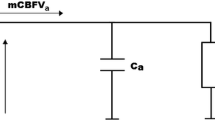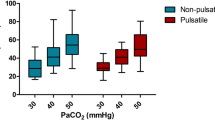Abstract
Despite increased risk of neurological complications after cardiac surgery, monitoring of cerebral hemodynamics during cardiopulmonary bypass (CPB) is still not a common practice. Therefore, a technique to evaluate dynamic cerebral autoregulation and cerebral carbon dioxide reactivity (CO2R) during normothermic nonpulsatile CPB is presented. The technique uses continuous recording of invasive arterial blood pressure, middle cerebral artery blood flow velocity, absolute cerebral tissue oxygenation, in-line arterial carbon dioxide levels, and pump flow measurement in 37 adult male patients undergoing elective CPB. Cerebral autoregulation is estimated by transfer function analysis and the autoregulation index, based on the response to blood pressure variation induced by cyclic 6/min changes of indexed pump flow from 2.0 to 2.4 up to 2.8 L/min/m2. CO2R was calculated from recordings of both cerebral blood flow velocity and cerebral tissue oxygenation. Cerebral autoregulation and CO2R were estimated at hypocapnia, normocapnia, and hypercapnia. CO2R was preserved during CPB, but significantly lower for hypocapnia compared with hypercapnia (p < 0.01). Conversely, cerebral autoregulation parameters such as gain, phase, and autoregulation index were significantly higher (p < 0.01) during hypocapnia compared with both normocapnia and hypercapnia. Assessing cerebral autoregulation and CO2R during CPB, by cyclic alteration of pump flow, showed an impaired cerebral autoregulation during hypercapnia.





Similar content being viewed by others
References
Aaslid R (2006) Cerebral autoregulation and vasomotor reactivity. Front Neurol Neurosci 66:825–832
Aaslid R, Lindegaard KF, Sorteberg W, Nornes H (1989) Cerebral autoregulation dynamics in humans. Stroke 20:45–52
Ainslie PN, Celi L, Mc Grattan K, Peebles K, Ogoh S (2008) Dynamic cerebral autoregulation and baroreflex sensitivity during modest and severe step changes in arterial PCO2. Brain Res 1230:115–124
Birch AA, Dirnhuber MJ, Hartley-Davies R, Iannotti F, Neil-Dwyer G (1995) Assessment of autoregulation by means of periodic changes in blood pressure. Stroke 26:834–837
Brady K, Joshi B, Zweifel C, Smielewski P, Czosnyka M, Easley RB, Hogue CW Jr (2010) Real-time continuous monitoring of cerebral blood flow autoregulation using near-infrared spectroscopy in patients undergoing cardiopulmonary bypass. Stroke 41:1951–1956
Brothers RM, Ganio MS, Hubing KA, Hastings JL, Crandall CG (2011) End-tidal carbon dioxide tension reflects arterial carbon dioxide tension in the heat-stressed human with and without simulated hemorrhage. Am J Physiol Regul Integr Comp Physiol 300:R978–R983
Brugniaux JV, Hodges AN, Hanly PJ, Poulin MJ (2007) Cerebrovascular responses to altitude. Respir Physiol Neurobiol 158:212–223
Cook DJ, Proper JA, Orszulak TA, Daly RC, Oliver WC Jr (1997) Effect of pump flow rate on cerebral blood flow during hypothermic cardiopulmonary bypass in adults. J Cardiothorac Vasc Anesth 11:415–419
Diehl RR, Linden D, Lucke D, Berlit P (1995) Phase relationship between cerebral blood flow velocity and blood pressure. A clinical test of autoregulation. Stroke 26:1801–1804
Diehl RR, Linden D, Lucke D, Berlit P (1998) Spontaneous blood pressure oscillations and cerebral autoregulation. Clin Auton Res 8:7–12
Edgell H, Robertson AD, Hughson RL (2012) Hemodynamics and brain blood flow during posture change in younger women and postmenopausal women compared with age-matched men. J Appl Physiol 112:1482–1493
Gommer E, Shijaku E, Mess W, Reulen J (2010) Dynamic cerebral autoregulation: different signal processing methods without influence on results and reproducibility. Med Biol Eng Comput 48:1243–1250
Gommer ED, Staals J, van Oostenbrugge RJ, Lodder J, Mess WH, Reulen JPH (2008) Dynamic cerebral autoregulation and cerebrovascular reactivity: a comparative study in lacunar infarct patients. Physiol Meas 29:1293–1303
Hamner JW, Cohen MA, Mukai S, Lipsitz LA, Taylor JA (2004) Spectral indices of human cerebral blood flow control: responses to augmented blood pressure oscillations. J Physiol 559(3):965–973
Huber P, Handa J (1967) Effect of contrast material, hypercapnia, hyperventilation, hypertonic glucose and papaverine on the diameter of the cerebral arteries: angiographic determination in man. Invest Radiol 2:17–32
Ide K, Eliasziw M, Poulin MJ (2003) Relationship between middle cerebral artery blood velocity and end-tidal PCO2 in the hypocapnic-hypercapnic range in humans. J Appl Physiol 95:129–137
Kadoi Y, Saito S, Goto F, Fujita N (2004) The effect of diabetes on the interrelationship between jugular venous oxygen saturation responsiveness to phenylephrine infusion and cerebrovascular carbon dioxide reactivity. Anesth Analg 99:325–331
Marinoni M, Ginanneschi A, Forleo P, Amaducci L (1997) Technical limits in transcranial doppler recording: inadequate acoustic windows. Ultrasound Med Biol 23:1275–1277
Markwalder T-M, Grolimund P, Seiler RW, Roth F, Aaslid R (1984) Dependency of blood flow velocity in the middle cerebral artery on end-tidal carbon dioxide partial pressure: a transcranial ultrasound Doppler study. J Cereb Blood Flow Metab 4:368–372
Murkin JM (1995) The role of CPB management in neurobehavioral outcomes after cardiac surgery. Ann Thorac Surg 59:1308–1311
Murphy GS, Hessel EA II, Groom RC (2009) Optimal perfusion during cardiopulmonary bypass: an evidence-based approach. Anest Analg 108:1394–1417
Nicolet J, Gillard T, Gindre G, Cervenansky F, Duale C, Bazin JE, De Riberolles C, Schoeffler P, Lemaire JJ (2005) Modifications of spontaneous cerebral blood flow oscillations during cardiopulmonary bypass. Acta Neurochir 95(Suppl):337–339
Ogawa Y, Iwasaki K, Aoki K, Shibata S, Kato J, Ogawa S (2007) Central hypervolemia with hemodilution impairs dynamic cerebral autoregulation. Anesth Analg 105:1389–1396
Panerai RB, Deverson ST, Mahony P, Hayes P, Evans DH (1999) Effects of CO2 on dynamic cerebral autoregulation measurement. Physiol Meas 20:265–275
Panerai RB, Eames PJ, Potter JF (2006) Multiple coherence of cerebral blood flow velocity in humans. Am J Physiol Heart Circ Physiol 291:H251–H259
Panerai RB (2008) Cerebral autoregulation: from models to clinical applications. Cardiovasc Eng 8:42–59
Paulson OB, Strandgaard S, Edvinsson L (1990) Cerebral autoregulation. Cerebrovasc Brain Metab Rev 2:161–192
Peebles K, Celi L, McGrattan K, Murrell C, Thomas K, Ainslie PN (2007) Human cerebrovascular and ventilatory CO2 reactivity to end-tidal, arterial and internal jugular vein PCO2. J Physiol 584(1):347–357
Peng T, Rowley A, Ainslie P, Poulin M, Payne S (2008) Multivariate system indentification for cerebral autoregulation. Ann Biomed Eng 36:308–320
Petersen KD, Lamdsfeldt U, Cold GE, Petersen CB, Mau S, Hauerberg J, Holst P, Skovgaard Olsen K (2003) Intracranial pressure and cerebral hemodynamic in patients with cerebral tumors: a randomized prospective study of patients subjected to craniotomy in propofol-fentanyl, isoflurane-fentanyl, or sevoflurane-fentanyl anesthesia. Anesthesiology 98:329–336
Sorteberg W, Lindegaard KF, Rootwelt K, Dahl A, Nyberg-Hansen R, Russell D, Nornes H (1989) Effect of acetazolamide on cerebral artery blood velocity and regional cerebral blood flow in normal subjects. Acta Neurochir 97:139–145
Strebel S, Lam AM, Matta B, Mayberg TS, Aaslid R, Newell DW (1995) Dynamic and static cerebral autoregulation during isoflurane, desflurane, and propofol anesthesia. Anesthesiology 83:66–76
Tiecks FP, Lam AM, Aaslid R, Newell DW (1995) Comparison of static and dynamic cerebral autoregulation measurements. Stroke 26:1014–1019
van Mook WNKA, Rennenberg RJMW, Schurink GW, van Oostenbrugge RJ, Mess H, Hofman PAM, de Leeuw PW (2005) Cerebral hyperperfusion syndrome. Lancet Neurol 4:877–888
Zhang R, Zuckerman JH, Giller CA, Levine BD (1998) Transfer function analysis of dynamic cerebral autoregulation in humans. Am J Physiol 274:H233–H241
Acknowledgments
The authors thank Prof. R.B. Panerai (University of Leicester, UK) and Dr. A.S. Sharma (Maastricht University Medical Centre and Cardiovascular Research Institute Maastricht - CARIM, Maastricht, the Netherlands) for their valuable contributions to the manuscript.
Conflict of interest
The authors declare no conflict of interest.
Author information
Authors and Affiliations
Corresponding author
Rights and permissions
About this article
Cite this article
Ševerdija, E.E., Gommer, E.D., Weerwind, P.W. et al. Assessment of dynamic cerebral autoregulation and cerebral carbon dioxide reactivity during normothermic cardiopulmonary bypass. Med Biol Eng Comput 53, 195–203 (2015). https://doi.org/10.1007/s11517-014-1225-z
Received:
Accepted:
Published:
Issue Date:
DOI: https://doi.org/10.1007/s11517-014-1225-z




